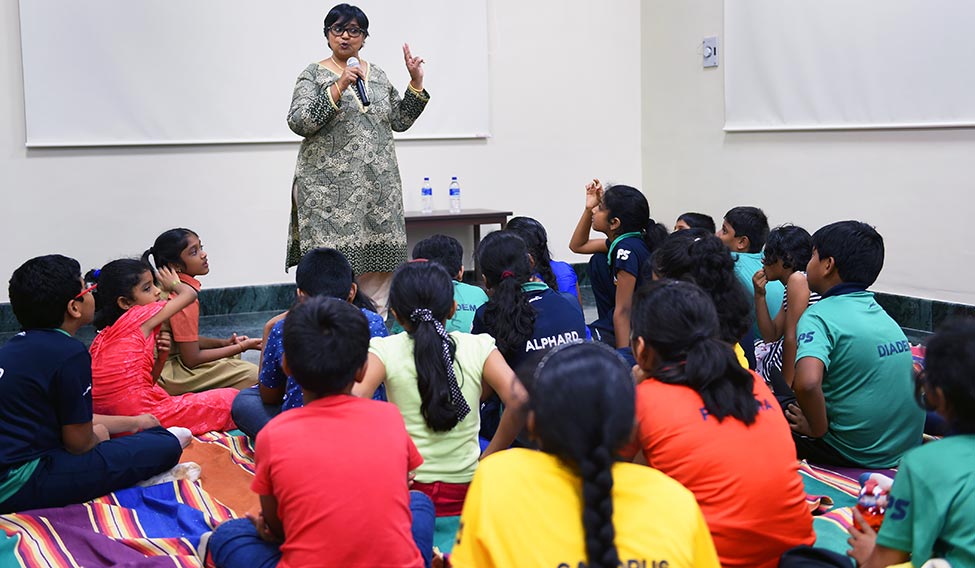She makes even the passing of time seem delightful. On a rainy Friday evening in Chennai, during the Madras Week celebrations in August, Jeeva Raghunath held a storytelling session for young listeners at Shiva Parvathi Pushpa Gardens, a sprawling green venue close to the popular suburb Anna Nagar. As a batch of students waited for a few of their school mates to arrive in the evening traffic hours, Raghunath kept the early birds effortlessly entertained. She mimicked the mosquitoes that had gathered around, breaking into an impromptu song about them, even making up a rhyme on the idea of waiting for people, getting the students to join in the chorus. Eventually as the audience trickled in and gathered around, Raghunathan, with her bright smile, twinkling eyes and sonorous sing-song captivating voice, was immediately lost in a sea of children—microphone and podium forgotten and water bottles strewn on one side—as a lively telling of tales ensued for an hour.
Raghunath is considered a founder of contemporary storytelling tradition in Tamil Nadu. It is not hard to see why. For the current session she has gathered, almost journalistically, an original story for the day, which, as a seasoned raconteur, she improvises on the spot. “It was meant to be for adults, but I have changed it to a story for kids,” she says. Raghunathan spent the earlier part of the day with Subbarao, a local wig-maker in the city, conversing deeply, taking in his craft, daily life, challenges and the larger issues of hair donation, which she then narrates to the children as a story about how wigs are made from hair sacrificed at temples, replete with visual details and voice effects. She also asks the kids to clap for a little girl in the audience who has donated her long hair to a cancer patient. “I want to sensitise children to people less privileged than them. As a storyteller, you got to empathise and dig into everything, every profession and feeling,” she explains. “The difference between theatre and storytelling is that the former is ‘outside’; you show the character; it is common property. The latter is ‘inside’; you visualise the character, which then becomes individual property.” Storytelling, she adds, is seen as a lifeskill now and is used in several fields, from business, education to, well, religion.
Raghunath, who has written a dozen books and translated more than 40 books for children in Tamil and English, started out as a pre-school teacher, before turning into a professional storyteller a decade ago. Her website describes her as, “Once upon a time there lived a talkative little girl… from morn to night she loved to talk to anybody and everybody. She had the gift of the gab even as early as five years old. She told stories to friends, neighbours, younger cousins and even to adults. She always had a crowd around her. Wherever she went, there was laughter, joy, fun, and she was admired by both young and the old. Some of her nicknames were Vayaadi (talkative girl), Gun Throat, Joker, Fatso and Jeeves.’ “I don’t like to market myself, people get to know of me mostly through word of mouth,” she says, almost shyly.
Raghunath has represented India at nearly 20 international storytelling festivals over the years, having given more than 500 solo performances, and trained nearly 25,000 adults and children in the art. She draws inspiration from Indian and Asian folktales, European tales, family stories and true life incidents.
Who are the storytellers she admires? “I like Dianne Ferlatte, Cathy Spagnoli and Margaret Read MacDonald, who have different styles. McDonald is an American folklorist who has done a lot of work in Thailand. I have translated Spagnoli’s book, Priya’s Day. Many have compared me to Ferlatte, an Afro-American storyteller, for the way we use our voice and singing in storytelling. The best part about storytelling is that each listener takes it differently. But it tickles everyone; there is a child in every adult.” What does she make of a revival of storytelling in India? “Storytelling in Asia, especially India and China, has had a long tradition but the west took it up. There was a revival there in the 1960s. Now, contemporary storytelling is happening here which puts the traditional in context.”
What is essential to be a good narrator? “Passion is the most important quality for a storyteller; emotion plays a big part. Other traits will follow. The technique is the same for children and adults,” she says, flashing a warm smile. It is no surprise then that 60-year-old Raghunath is the favourite aunt of her nine grandnieces and grandnephews, with whom bonds have been built, she says, fittingly, over stories.
SHARERS OF STORIES
Cathy Spagnoli, an American storyteller who battled brain cancer in 2008, was married to Indian sculptor Paramasivam. She made several trips to India and neighbouring countries, finding herself drawn to Asian storytelling. She brought out a story from each Indian state in her book—The World of Indian Stories.
Folklorist Margaret Read MacDonald worked as a children’s librarian in the United States for more than three decades and is known for her ‘tellable’ story collections.








